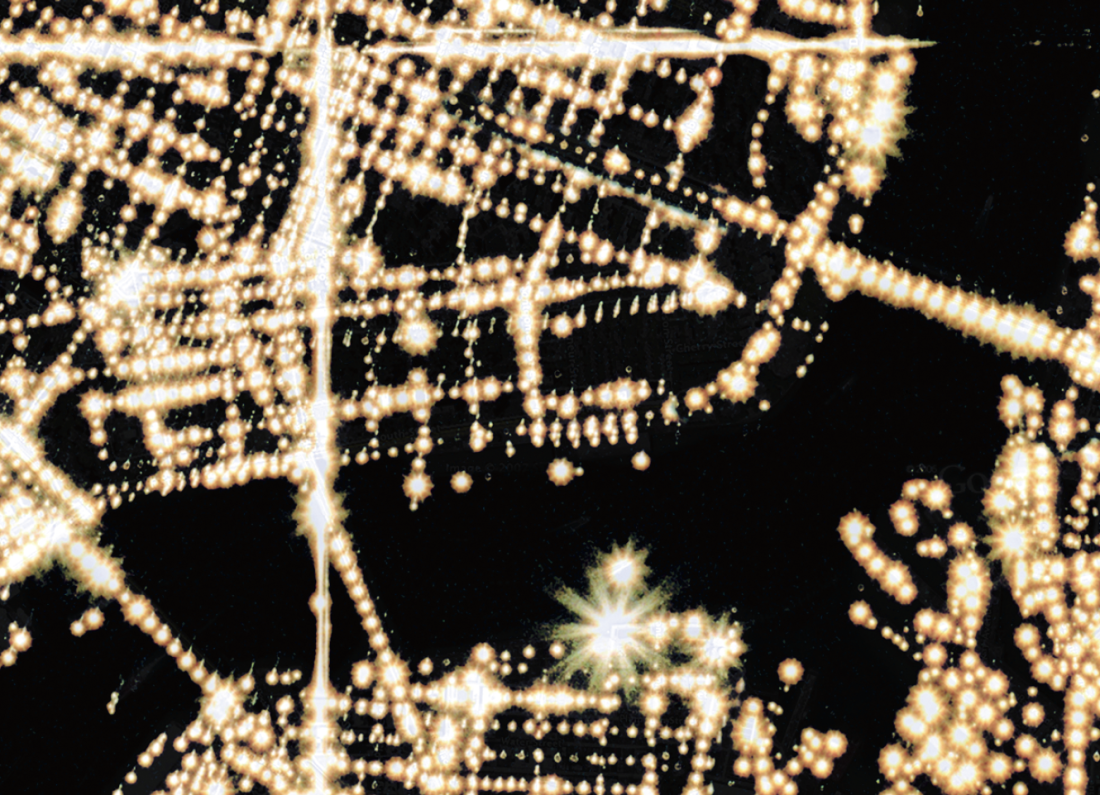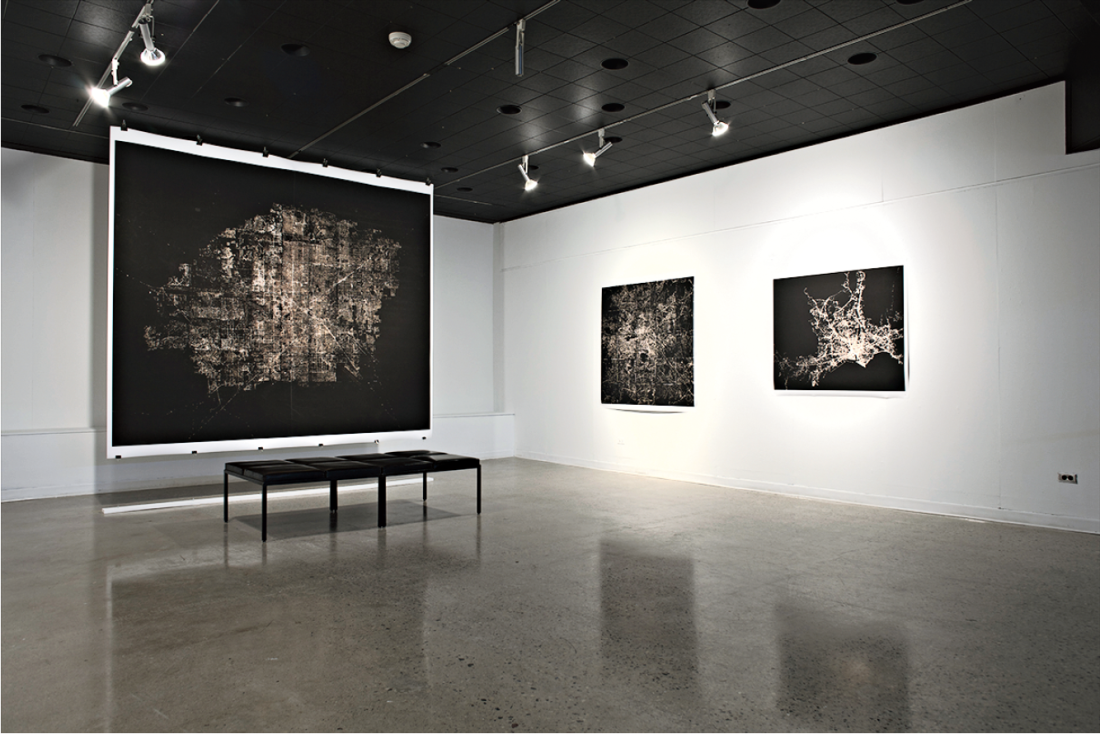Anna von Gwinner and Markus Schädel
…If we could…hover over this great city, gently remove the roofs, and peep in at the queer things which are going on, the strange coincidences, the plannings, the cross-purposes, the wonderful chains of events…it would make all fiction…most stale and unprofitable.
From A Case of Identity by Arthur Conan Doyle
“after dusk,” Anna von Gwinner’s exhibition at the University of Manitoba’s arch 2 Gallery is this Berlin artist and architect’s second appearance in Winnipeg. Her first was in 2007 when she showed a piece entitled Downpour, a traffic-stopping video installation that, over a period of several days, appeared from the street to show Plug In ICA’s downtown gallery space filling slowly, floor to ceiling, with water.
“after dusk” features six prints of what seem to be streetlight-illuminated, satellite views of different cities. They were produced with the assistance of her colleague Markus Schädel. Five of the pieces were mounted on opposing walls of the gallery’s three-sided, open white box. The sixth, much larger, hung full centre stage toward the back, suspended from the ceiling facing the glass entrance wall. As is usual with ARCH 2, the works stand naked and alone, unsupported or, some might say, unhampered by any of the usual curatorial or artist statements, artist biographies or titles. For a gallery experience, this is about as unmediated as it gets; both art and audience are on their own, sink or swim. What’s experienced, what is taken away, is strictly between the viewer and the art. While some may argue that this represents an abdication of a gallery’s traditional responsibility to enhance accessibility and audience comprehension, I, for one, have some sympathy with the approach, demanding as it does of each viewer a more direct and personal engagement with the works themselves.

Anna von Gwinner, New York, 2009, digital print, 152 cm x 111 cm. Courtesy the artist.
Apart from their apparently representational character as cityscapes, von Gwinner’s images are, in the most literal sense of the word, attractive. The myriad glittering punctuations of yellow and gold that erupt from the inky blackness of these prints have an indisputable, feral magpie appeal. At a more cognitive level, however, it seems impossible not to try to locate and name the represented cities. For me, New York is easy, as is Venice. For Germans and likely other Europeans, Berlin, I suspect, is similarly obvious. The others though: La Paz, Las Vegas and Marseille, locations I can now identify only because I asked, seem far less so, raising the question as to whether this level of specificity matters to the artist or, in which case, whether it should to the audience either. The temptation is very much to say no, and yet, closer examination reveals puzzling ambiguities that would seem to contradict this view. The blackness, for example, which, were it total, would make of the images little more than two dimensional, graphic renderings, is neither absolute nor uniform. Rather, it is subtly modulated, revealing the barely, though still clearly, discernible interstitia of urban infrastructure: the identifying parks, squares, stadia and, in some cases, encompassing topographies that in the uniqueness of their interrelationships stand as a challenge to anonymity. Herein, too, resides another of the great puzzles and, indeed, pleasures of these works, for while the above would seem to enhance the veracity of their association with a particular original, this view in turn is countered by the improbability of some of the light blooms that appear to mark out roadways and other boundaries. The realization that these prints are not, as first impressions suggest, unmanipulated, photographic representations but, instead, astonishingly labour-intensive constructs serves more to enhance than detract from the wonder of them; illusions they may be, but grand illusions, masterfully or perhaps better to say, msfully, done.
At their most elementary, these twice human-altered landscapes of von Gwinner may be viewed as straightforward mappings, and as any traveller knows, maps not only engage the armchair imagination but, more significantly when venturing into the exotic, also serve as a kind of security blanket. Elementary, however, does not mean simple; for as maps, these are seriously incomplete, displaying virtually none of the adjuncts necessary to their functioning as aids to physical navigation. They lack identity—there are no titles or labels, nothing is named, and names of course are the tools we use to overcome and control our life passage. What we see in these pieces may be recognizable as references to known cities, but they are, and it seems are meant to be, essentially generic.
This removal of nominal constraints does have significant advantages, though. Freeing the imaginative and intellectual flâneur from the straitjacket of specificity opens doors to other more expansive experiential strategies. Like the philosopher’s tree and in common with all artistic representations of the real, the degree of meaning in landscape works is roughly commensurate with their capacity to engage the imagination. In conventional landscape views, that is, those that present as a recording of a here/now, this seldom goes much further than a viewer’s projection into the rendered moment. In von Gwinner’s work, though, the potentials are hugely extended, arcing from and through ancestral scribings into an immediate present and possibly beyond.

Installation view, Anna von Gwinner and Markus Schädel, Las Vegas, Berlin, Marseille. From left, Las Vegas, 284 cm x 322 cm, Berlin, 155 cm x 148 cm, Marseille, 121 cm x 136 cm, 2009 digital print. Photo courtesy of William Eakin and ARCH 2 Gallery, Faculty of Architecture, University of Manitoba.
To look down into the layout of any expression of extended human habitation, whether it is village, town or city, is to witness the memorial, evolutionary tracings of a society’s interface with its environment. This is particularly true of von Gwinner’s interpretations. As maps they may fail, but as dynamic time capsules they are stunningly successful. Evident to a greater or lesser degree in all of her cities, this is especially true of what she has chosen to bring out in her representations of the oldest—those built and rebuilt upon the sites of ancient cultures. In these, many of the roads and byways appear to meander lazily outward from their centres. Rather than thrusting into the surrounding landscape, they follow paths of least resistance, flowing like gentle streams, not consuming territory so much as infiltrating or embracing it. Overlayered upon and frequently disrupting the delicacy of these organic interactions are the ordered, rectangular geometries of latter-day planning that von Gwinner highlights, an indication, I think, of a creeping, perceptual shift that has taken humanity from the accommodating to the adversarial, from being accepting of a harmonious, symbiotic relationship with the world to one that demands hierarchy and dominance.
Next to the crop of currently fashionable, computer-generated, photographically based, constructed landscapes, these pieces of von Gwinner’s may to many seem slightly uneven and imprecise. This I’m sure is especially true for those expecting digital exactitude. By contemporary standards, the prints are a bit rough around the edges, a feature that gives them the unmistakably analogue air of having been made rather than processed. Yet, more than anything else, it is also this implied directness of connection with an active, human intelligence that draws me in. In their clear evidence of handiwork, these pieces display a syntax more sympathetic to eye and mind, and that, somehow, makes them seem more true. ❚
“after dusk” was exhibited at the Faculty of Architecture’s ARCH 2 Gallery at the University of Manitoba in Winnipeg from March 7 to April 15, 2011.
Richard Holden is a photographer who lives in Winnipeg.

